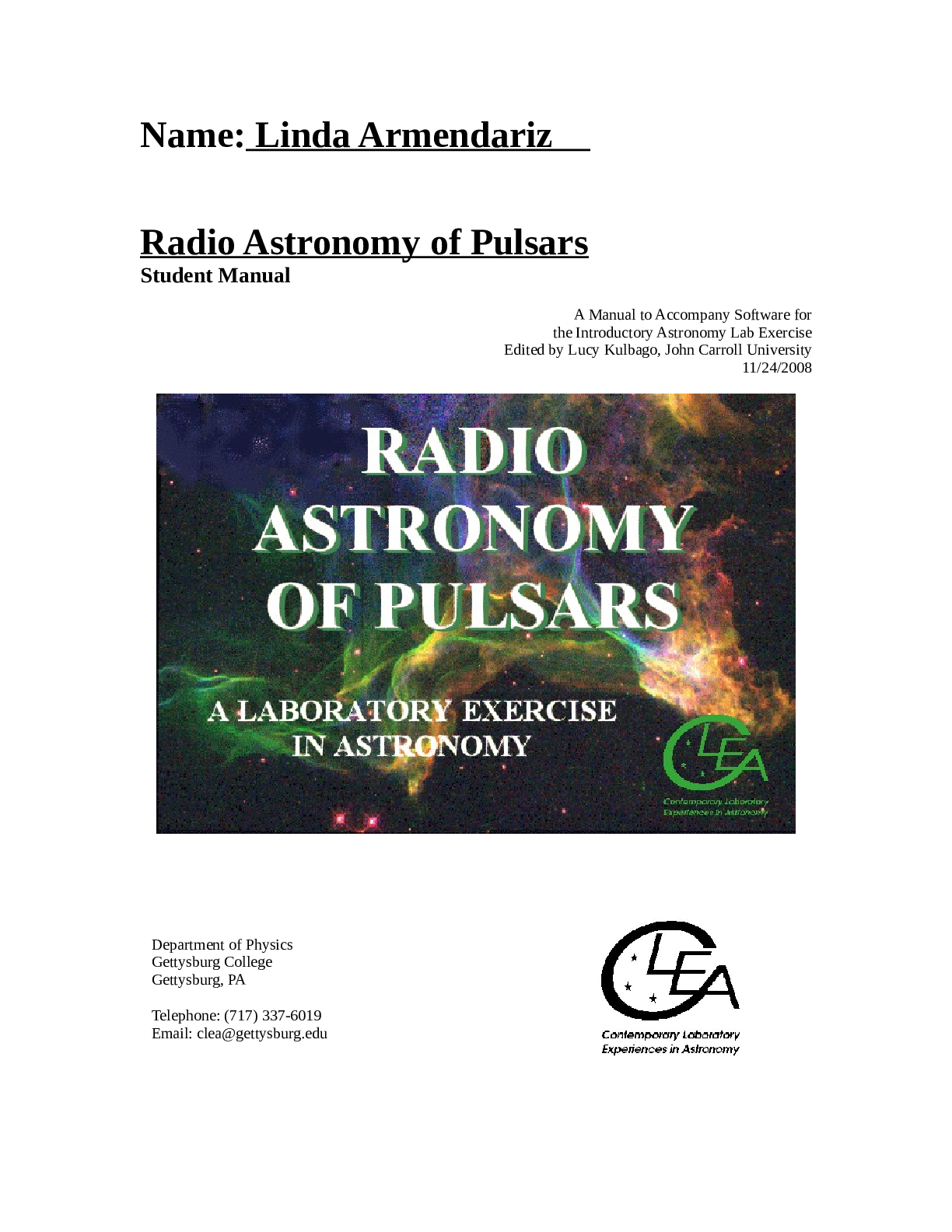Radio Astronomy of Pulsars
Document Content and Description Below
Radio Astronomy of Pulsars Student Manual A Manual to Accompany Software for the Introductory Astronomy Lab Exercise Edited by Lucy Kulbago, John Carroll University 11/24/2008 Department of Phys... ics Gettysburg College Gettysburg, PA Telephone: (717) 337-6019 Email: [email protected] Manual Goals You should be understand the fundamental operation of a radio telescope and recognize how it is similar to, and different from, an optical telescope. You should understand how astronomers, using radio telescopes, recognize the distinctive properties of pulsars. You should understand what is meant by interstellar dispersion, and how it enables us to measure the distances to pulsars. Objectives If you learn to....... Use a simulated radio telescope equipped with a multi-channel receiver. Operate the controls of the receiver to obtain the best display of pulsar signals. Record data from these receivers. Analyze the data to determine properties of the pulsars such as periods, signal strengths at different frequencies, pulse arrival times, relative strengths of the signals. You should be able to..... Understand the basic operation and characteristics of a radio telescope. Compare the periods of different pulsars, and understand the range of periods we find for pulsars. Understand how a pulsar’s signal strength depends on frequency. Useful Terms You Should Review Using Your Textbook Crab Nebula interstellar medium pulsar frequency Declination Julian Date radio telescope parsecs dispersion magnetic field radio waves period electromagnetic spectrum neutron star resolution speed of light electromagnetic radiation Universal Time (UT) Right Ascension 2Background: Neutron Stars and Pulsars Many of the most massive stars, astronomers believe, end their lives as neutron stars. These are bizarre objects so compressed that they consist entirely of neutrons, with so little space between them that a star containing the mass of our sun occupies a sphere no larger than about 10 km. in diameter, roughly the size of Manhattan Island. Such objects, one would think, would be extremely hard, if not impossible, to detect. Their surface areas would be several billion times smaller than the sun, and they would emit so little energy (unless they were impossibly hot) that they could not be seen over interstellar distances. Astronomers were therefore quite surprised to discover short, regular bursts of radio radiation coming from neutron stars—in fact it took them a while before they realized what it was they were seeing. The objects they discovered were called pulsars, which is short for “pulsating radio sources.” The discovery of pulsars was made quite by accident. In 1967, Jocelyn Bell, who working for her Ph.D. under Anthony Hewish in Cambridge, England, was conducting a survey of the heavens with a new radio telescope that was designed specifically to look for rapid variations in the strengths of signals from distant objects. The signals from these objects varied rapidly in a random fashion due to random motions in the interstellar gas they pass through on their way to earth, just as stars twinkle randomly due to motions of air in the earth’s atmosphere. Bell was surprised one evening in November, 1967 to discover a signal that varied regularly and systematically, not in a random fashion. It consisted of what looked like an endless series of short bursts of radio waves, evenly spaced precisely 1.33720113 seconds apart. (See Figure 1, which shows the chart on which Bell first discovered the pulses.) The pulses were so regular, and so unlike natural signals, It was only about six months after their discovery that theoreticians came up with an explanation for the strange pulses: they were indeed coming from rapidly spinning, highly magnetic, neutron stars. Tommy that, for a while, Bell and Hewish tried to find some artificial source of radiation —like a radar set or home appliance— that was producing the regular interference. It soon became clear that the regular pulses moved across the sky like stars, and so they must be coming from space. The astronomers even entertained the idea that they were coming from “Little Green Men” who were signaling to the earth. But when three more pulsating sources were discovered with different periods (all around a second in length) and signal strengths in different parts of the sky, it became clear that these “pulsars” were some sort of natural phenomenon. When Bell and Hewish and their collaborators published their discovery, in February 1968, they suggested that the pulses came from a very small object—such as a neutron star—because only an object that small could vary its structure or orientation as fast as once a second. Figure 1: Chart on which Jocelyn Bell discovered her first pulsar 3Student Manual Gold of Cornell University was the first to set down a this idea, and, though many details have been filled in over the years, the basic idea remains unchanged. We would expect neutron stars to be spinning rapidly since they form from normal stars, which are rotating. When a star shrinks, like a skater drawing her arms closer to her body, the star spins faster (according to a principle called conservation of angular momentum). Since neutron stars are about 100,000 times smaller than normal stars, they should spin 100,000 times faster than a normal star. Our sun spins once very 30 days, so we would expect a neutron star to spin about once a second. A neutron star should also have a very strong magnetic field, magnified in strength by several tens of billions over that of a normal star—because the shrunken surface area of the star concentrates the field. The magnetic field, in a pulsar, is tilted at an angle to the axis of rotation of the star (see Figures 2a and 2b). Now according to this model the rapidly spinning, highly magnetic neutron traps electrons and accelerates them to high speeds. The fast-moving electrons emit strong radio waves which are beamed out like a lighthouse in two directions, aligned with the magnetic field axis of the neutron star. As the star rotates, the beams sweep out around the sky, and every time one of the beams crosses our line of sight (basically once per rotation of the star), we see a pulse of radio waves, just like a sailor sees a pulse of light from the rotating beacon of a lighthouse. Axis of Rotation Earth Radio Waves Figure 2A The pulse is “on.” The Earth receives the radio waves. Pulsar Magnetic Axis Figure 2B The pulse is “off.” The Earth does not detect the radio waves. [Show More]
Last updated: 1 year ago
Preview 1 out of 11 pages

Buy this document to get the full access instantly
Instant Download Access after purchase
Add to cartInstant download
We Accept:

Reviews( 0 )
$10.00
Document information
Connected school, study & course
About the document
Uploaded On
May 21, 2021
Number of pages
11
Written in
Additional information
This document has been written for:
Uploaded
May 21, 2021
Downloads
0
Views
105












.png)

